SS City of Chester
Passenger steamship rammed and sunk by the RMS Oceanic of White Star Line in San Francisco.
Year Built
1875
Year Sank
1888
Depth
217 ft (66.1 m)
Difficulty Level
Advanced

SS City of Chester, owned by the Oregon Railway and Navigation Company.
SS City of Chester
Wreck Location
The remains of the City of Chester lie in San Francisco Bay east of the Golden Gate Bridge. She lies within the city of San Francisco's limits underneath a busy shipping lane. On the west side of the bridge is the wreck of the ocean liner City of Rio de Janeiro. The wreck and location were originally discovered by the tugboat Raymond in 1888 and rediscovered in 2013 by a NOAA team lead by Dr. James Delgado. The water is very cold and has a strong current, making diving incredibly difficult. Due to her depth and the strong currents in the Golden Gate, divers need to have a lot of experience when trying to dive to the wreck.
~ GPS Shipwreck Location ~
Latitude: 37° 48' 50.0004" N Longitude: -122° 28' 0.0012" W
Description

(The Oregon Railway and Navigation Company's City of Chester.)
The City of Chester was built in 1875 for the Oregon Steamship Company by the Delaware Iron Shipbuilding and Engine Works of John Roach and Sons in Chester, Pennsylvania. Her namesake was the city of which she was built in. She was powered by a single propeller and compound condensing steam engine. She also had two masts able to be rigged with auxiliary sails and a single funnel with a tall wood superstructure and iron hull to complete her profile. She entered service in 1877 alongside the former Old Dominion Steamship Company night liner George W. Elder and replaced the steamship John L Stephnes. Both the City of Chester and George W. Elder operated on the Portland, Oregon to San Francisco, California run. In 1878, the two steamers were joined by a third Chester built steamship called the Oregon. In 1879, a fourth ship was ordered by the company and was ultimately delivered in early 1880 as the revolutionary electric steamship Columbia. During 1879, the Oregon Steamship Company was bought and merged into Henry Villards local mammoth the Oregon Railway and Navigation Company. City of Chester compared to her fleetmates was a very modest little steamship only 202 feet long and carrying only able to carry 414 passengers of both first class and steerage. In contrast, the company flagship, Columbia, was 320 feet long and could carry over 600 passengers of both classes. She was even 50 feet smaller than the later Pacific steamship Valencia. Nevertheless, it appears the City of Chester did her job well.

(The City of Chester sinking after colliding with the legendary White Star Liner RMS Oceanic.)
In 1888, the Oregon Railway and Navigation Company leased the City of Chester to the Pacific Coast Steamship Company, another coastal steamship company which operated on more routes and to more destinations than the OR&N. The City of Chester during the charter was placed on the Eureka to San Francisco route. On August 22, 1888, fate was to be very cruel to the little City of Chester. In the infamous San Francisco fog, City of Chester was hit by the White Star Line ocean liner RMS Oceanic. Oceanic was under lease to the Occidental and Oriental Steamship Company being used on the Hong Kong to San Francisco route. Oceanic was also the first steamship to be built for the White Star Line back in 1870 and was sister ships with the ill fated RMS Atlantic. The damage to the City of Chester was remarkable the Oceanic having sliced through half her hull. She began taking on water immediately. In a scene of complete chaos seen as the British crew of Oceanic looked onward horrified as City of Chester slipped beneath the waves in six minutes taking with her 13 passengers and crew. The Oceanic's crew immediately began rescue efforts and rescued her remaining passengers and crew. Due to racism of the time, her Chinese-American crew was heavily criticized for "allowing City of Chester's passengers to drown" when in reality that was far from the truth. The crew had done everything possible to help their passengers.
City of Chester now lies in 217 feet of water. Her hull has mostly rotted away to the point where only the bottom of the hull is left, exposing completely the twin boilers and single steam engine, which are the tallest features of the wreck. It is hardly recognizable as the steamship that was sunk by the Oceanic to the untrained eye. The salt water and torrential currents off San Francisco are most likely to blame for this bad deterioration.
Footnotes
City of Chester, despite the very miniscule loss of life, is apparently the second deadliest shipwreck in San Francisco history. The deadliest is the City of Rio De Janeiro where 135 people were drowned in a violent and horrying death. Janeiro also in far better shape than the Chester with her entire hull being intact.